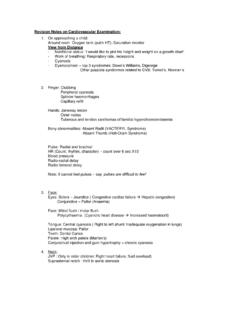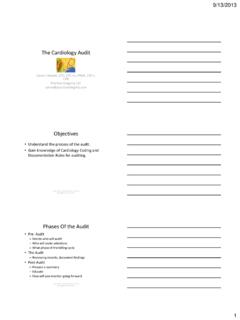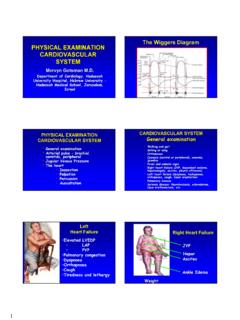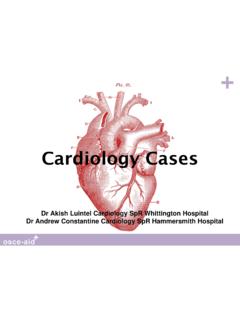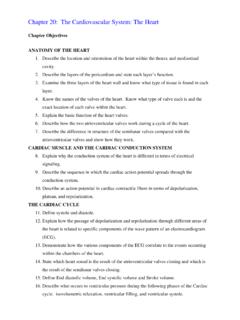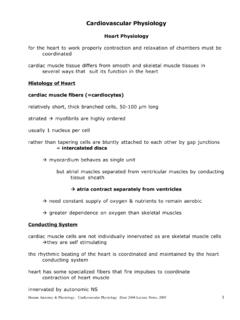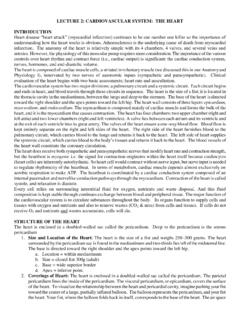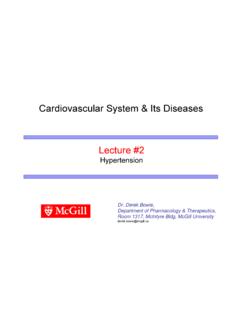Transcription of Systems Physiology I: Cardiovascular, Respiratory, and ...
1 IntroductionBioengineering 6000 CV Physiology Systems Physiology I: cardiovascular , Respiratory, and Renal SystemsBioengineering 6000 CV PhysiologyIntroductionQuote of the Day (Week, or Semester) A mediocre person tells. A good person explains. A superior person demonstrates. A great person inspires others to see for themselves."Harvey MackayHarvey Mackay (born 1932 in Saint Paul, Minnesota) is a businessman and columnist. Mackay is perhaps best known as the author of five business bestsellers, including Swim With the Sharks (Without Being Eaten Alive), Beware the Naked Man Who Offers You His Shirt and Dig Your Well Before You're Thirsty. He is a nationally syndicated columnist, and one of America's most popular business speakers. He is also founder, Chairman and CEO of Mackay Envelope Corporation, whose story he tells in anecdotes sprinkled throughout his 6000 CV PhysiologyIntroductionOrganization Instructors: Rob MacLeod TA: Andrew Miller Web page: ~macleod/be6000 Canvas page.
2 6000 CV PhysiologyIntroductionWeb SiteBioengineering 6000 CV PhysiologyIntroductionCanvasBioengineeri ng 6000 CV PhysiologyIntroductionLecture Syllabus Cardiac electrophysiology/mechanics Membrane and cellular structure/function Action potentials Cardiac tissue and bioelectricity Cardiac mechanics, regulation cardiovascular structure/function Vascular system Hemodynamics, transport, regulation Respiration Gases and gas transport Ventilation Regulation Renal function Osmotic regulation Renal transport RegulationBioengineering 6000 CV PhysiologyIntroductionLab Syllabus Sessions: Dissection of CV system (bovine heart) Regulation of cardiac function (frog) Exercise and blood pressure ECG Pulmonary function Simulation TA: Andrew Miller 6000 CV PhysiologyIntroductionScheduleBioenginee ring 6000 CV PhysiologyIntroductionResource Material Class web page : ~macleod/be6000 Text: Eckert Animal Physiology , Randall, Burggren, & French Notes: available before most lectures on the web site in pdf format.
3 Study topic list: prepared before each major test Additional references (see web site): Human Physiology : An Integrated Approach by Silverthorn Physiology by Berne and Levy; Mathematical Physiology by Keener and Sneyd cardiovascular Physiology by Mohrman and 6000 CV PhysiologyIntroductionLabs Goals: Put theory into practice Get exposure to real biological data Encourage sound analysis and interpretation Develop/improve writing and organizational skills Explore Design of Experiments Guidelines: Generally two lab days per lab (Friday/Monday, Friday/Tuesday, Wed/Friday) Sign up for the lab Doodle Poll: see web site Review lab instructions and associated web sites for Friday Start of lab time: 12:00 on Friday, 1:00 pm MondayBioengineering 6000 CV PhysiologyIntroductionLab Logistics Lab time: Friday at 12:00 and Monday at 1:00 PM First lab: Friday, Jan 10 (this week!)
4 !) Lab materials Camera (one per team) Tolerant, comfortable clothesBioengineering 6000 CV PhysiologyIntroductionLab Reports Writing/presentation is important! Format varies with the lab Emphasis on results and discussion Requirement of clear, logical, concise scientific writing Plentiful feedback (our job) Resubmissions allowed (on first two labs)Bioengineering 6000 CV PhysiologyIntroductionMy Expectations Already possess a basic understanding of human Physiology , , Human Physiology : in Integrated Approach, by Silverthorn Already have a working knowledge of MATLAB Immediately check Canvas: see web site for instructions Already have previous experience with writing lab reports Plan to read the text (during the semester) Plan to read some literature Ask questions and participateStudents should:Bioengineering 6000 CV PhysiologyIntroductionOur Deliverables Intermediate level coverage of cardiovascular Physiology Generalized approach to physiological Systems Lab experiences that integrate class material Design of experiments Feedback and a chance to act on that feedback Flexible syllabus based on class interest Answers to the Why Should We Care?
5 Question at any time Experiment with peer learning Accessibility: after class and by email are bestWe will offer:Bioengineering 6000 CV PhysiologyIntroductionGrading Exams: 3 * 15% = 45% of total grade Types of questions True/false with explanation Describe a mechanism Explain an observation Interpret data Labs: 30% 6 labs with written reports, Semester project: 20% Written exploration of extreme Physiology Homework: 5% 2-3 homework assignments Simulations, calculationsIntroductionBioengineering 6000 CV PhysiologyDeath Zone VideoMotivation and background for semester projectBioengineering 6000 CV PhysiologyIntroductionComments from VideoStructureContentApproachMessageBioe ngineering 6000 CV PhysiologyIntroductionLab SchedulingBioengineering 6000 CV PhysiologyIntroductionLab SchedulingDecisionFriday Lab: 2:00 Monday Lab: 1:00 Bioengineering 6000 CV PhysiologyIntroductionLab SchedulingHeather s reply re BIOEN 4202 Friday sessions: I haven t had any students in the past approach me with anything I couldn t work around, so I don t anticipate it being an issue the students can t manage.
6 Bioengineering 6000 CV PhysiologyIntroductionLab Planning and PracticeGoalsBeforeDuringAfterLogisticsD ata AcquisitionData ProcessingCareful ExecutionCleanupBioengineering 6000 CV PhysiologyIntroductionExcellent Photo ExampleBioengineering 6000 CV PhysiologyIntroductionAnd AnotherBioengineering 6000 CV PhysiologyIntroductionCow Specific InformationIntroductionBioengineering 6000 CV PhysiologyMeanwhile, Back in the 6000 CV PhysiologyIntroductionLearning Approach: Problem SolvingBioengineering 6000 CV PhysiologyIntroductionLearning Approach: MotivationBy Force?Bioengineering 6000 CV PhysiologyIntroductionDon t memorizeAsk Good Questions!So what are some good questions?Bioengineering 6000 CV PhysiologyIntroductionLearning Approach:Finding Good QuestionsAnn , annual swimsuit issue, 4(2) March/April 1998 Scott Sandford, NASAB ioengineering 6000 CV PhysiologyIntroductionPeer Learning Peer learning is based in real work: sharing what one is doing with others, asking for support, questions and answers and feedback.
7 6000 CV PhysiologyIntroductionPlagiarismWhat is it?1. To use and pass off as one s own (the ideas or writings of another).2. To appropriate for use as one s own passages or ideas from (another).3. To put forth as original to oneself the ideas or words of is it bad?Reputation and fraudThe 6000 CV PhysiologyIntroductionHow Do We Reconcile?versusBioengineering 6000 CV PhysiologyIntroductionWhy Animal Physiology ?Bioengineering 6000 CV PhysiologyIntroductionWhy Animal Physiology ?Bioengineering 6000 CV PhysiologyIntroductionWhy Animal Physiology ?Bioengineering 6000 CV PhysiologyIntroductionWhy Animal Physiology ? Scientific curiosity animals can do things humans cannot! Insights into human Physiology source of experimental models similarities and differences important to know Bioengineering strategies Bio-based approach Commercial/agricultural applications veterinary medicine genetically modified/cloned animalsIntroductionBioengineering 6000 CV PhysiologyPhysiological Has Central of change: Adaptation, acclimatization, and and regulation control systemsBioengineering 6000 CV PhysiologyIntroduction1.
8 Structure/Function Relationships Function follows from structure, , different muscle forms have different function skeletal smooth cardiac Present across scales Bioengineering 6000 CV PhysiologyIntroduction2. Mechanisms of Change Adaptation passed by genetic material, slow, not reversible occur by mutation, selected by environment can be difficult to determine, must bring survival advantages, , same response to same stress across different speciesDyann WirthOptimalityAdaptationGood EnoughAdaptationBioengineering 6000 CV PhysiologyIntroduction2. Mechanisms of Change Acclimatization change in response to exposure to environment relatively rapid and reversible , response to change in altitude Acclimation same as acclimatization but induced by and AcclimationBioengineering 6000 CV PhysiologyIntroduction3. Homeostasis System to remove or attenuate response to external changes Produces constant internal environment , body temperature Effective across scales Different animals respond differently to same stressBioengineering 6000 CV PhysiologyIntroduction4.
9 Conformity and Regulation Internal = external , starfish (salinity)annelid worms (oxygen) Internal != external , crustations (oxygen)mammals (temperature, etc.) Central to all Physiology Mechanism for homeostasis Positive versus negative feedback Set point GainBioengineering 6000 CV PhysiologyIntroduction5. Feedback controlBioengineering 6000 CV PhysiologyIntroductionCausality and Teleology Teleology: A thing, process or action is teleological when it is for the sake of an end, , a telos or final cause. The use of ultimate purpose or design as a means of explaining phenomena. Avoid this type of thinking in science as we cannot tell purpose. Example (from lab report): One initial observation is that the right lung is much larger than the left lung. This makes sense physiologically since the heart is generally located on the left side of the body; therefore to optimize lung capacity, the right lung has more room inside of the body to grow.
10 6000 CV PhysiologyIntroductionFeatures of cardiovascular Physiology Blood is thicker than water (it is a suspension of particles) Blood vessels are not pipes (walls are elastic, contractile) The heart is a "permissive" pump (follows rather than leads) Most heart failure is electrical not mechanical in origin Physiology is physics (just complicated physics) Homeostasis = control(Why engineers might hate Physiology )(Why engineers should love Physiology )Bioengineering 6000 CV PhysiologyIntroductionOverall Causes of DeathBioengineering 6000 CV PhysiologyIntroductionWorld CV Death rates (men)CV DiseasesAll CausesBioengineering 6000 CV PhysiologyIntroductionWorld CV Death rates (women)CV DiseasesAll CausesBioengineering 6000 CV PhysiologyIntroductionCV Disease Rates: US#1: New York#52: S. CarolinaUtah: #11#1: New Mexico#52: New YorkUtah: #3 Rank: Low to HighCHDS trokeBioengineering 6000 CV PhysiologyIntroductionThe Updated TrendsBioengineering 6000 CV PhysiologyIntroductionCardiovascular System Overview The plumbing: circulation Systems in the body The wiring: cardiac electrophysiology The pump: the heart as a pump The flow: blood and hemodynamics The control: brain/hormonal/local, feedbackBioengineering 6000 CV PhysiologyIntroductionCardiovascular System Regulation Goal: adequate flow Process: pump and flow Regulation: parallel circuit with valves Sensors?


